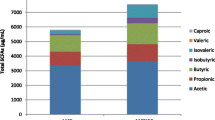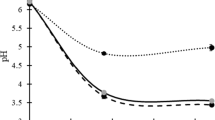Abstract
Equol improves menopausal symptoms and it is synthesized from daidzein, one of the isoflavonoids in soybeans, by the bacteria in the large intestines of some people. The purpose of this study was to isolate equol-producing bacteria using daidzein from the intestinal microflora and to produce equol-containing chungkookjang (short-term fermented soybean). Equol-producing bacteria from the feces of Sprague–Dawley female rats were isolated using media containing daidzein. The isolated bacteria were cultured in thioglycollate media and equol production was identified through thin-layer chromatography and ultraperformance liquid chromatography–mass spectrometry. The bacteria were identified by 16S rRNA sequencing. The rate of equol production in different concentrations of daidzein was assessed. The expression of genes that code for enzymes associated with the production of equol from daidzein was detected through reverse transcription quantitative PCR. The bacterium we isolated was Lactobacillus intestinalis (LC096206.1, 99%). L. intestinalis was found to express daidzein reductase, dihydrodaidzein reductase, and tetrahydrodaidzein reductase, the enzymes involved in producing equol from daidzein. The conversion rate of equol from daidzein was highest (29.5%) using 200 μM daidzein for 48 h of incubation. When chungkookjang fermented with Bacillus amyloquencies SRCM100001 was incubated with L. intestinalis, 0.32 ± 0.04 mg equol/g chungkookjang was produced. In conclusion, L. intestinalis efficiently produces equol from not only daidzein but also in chungkookjang.





Similar content being viewed by others
Explore related subjects
Discover the latest articles and news from researchers in related subjects, suggested using machine learning.References
Abiru Y, Kumemura M, Ueno T, Uchiyama S, Masaki K (2012) Discovery of an S-equol rich food stinky tofu, a traditional fermented soy product in Taiwan. Int J Food Sci Nutr 63:964–970
Ahmadi SM, Khomiri M, Khosroushahi A, Kashaninezhad M (2009) Isolation and identification of lactic acid bacteria (LAB) from Iranian traditional Lighvan cheese. J Agric Sci Nat Res 16:136–146
Akaza H et al (2004) Comparisons of percent equol producers between prostate cancer patients and controls: case-controlled studies of isoflavones in Japanese, Korean and American residents. Jpn J Clin Oncol 34:86–89
An-yi W, Yong-qiang C, Xiao-qun O, Xiao-nan L, Ting L (2014) Thin-layer chromatography (TLC) high performance liquid chromatography(HPLC) equol genistein. Sci Technol Food Ind 35:79–82
Atkinson C, Frankenfeld CL, Lampe JW (2005) Gut bacterial metabolism of the soy isoflavone daidzein: exploring the relevance to human health. Exp Biol Med 230:155–170
Axelson M, Kirk DN, Farrant RD, Cooley G, Lawson AM, Setchell KD (1982) The identification of the weak oestrogen equol [7-hydroxy-3-(4′-hydroxyphenyl)chroman] in human urine. Biochem J 201:353–357
Chen MN, Lin CC, Liu CF (2015) Efficacy of phytoestrogens for menopausal symptoms: a meta-analysis and systematic review. Climacteric 18:260–269
Clarkson TB et al (2011) The role of soy isoflavones in menopausal health: report of The North American Menopause Society/wulf H. Utian Translational Science Symposium in Chicago, Il (October 2010). Menopause 18:732–753
Daily JW, Ko BS, Ryuk J, Liu M, Zhang W, Park S (2019) Equol decreases hot flashes in postmenopausal women: a systematic review and meta-analysis of randomized clinical trials. J Med Food 22:127–139
Decroos K, Vanhemmens S, Cattoir S, Boon N, Verstraete W (2005) Isolation and characterisation of an equol-producing mixed microbial culture from a human faecal sample and its activity under gastrointestinal conditions. Arch Microbiol 183:45–55
Frankenfeld CL et al (2005) High concordance of daidzein-metabolizing phenotypes in individuals measured 1 to 3 years apart. Br J Nutr 94:873–876
Fujisawa T, Itoh K, Benno Y, Mitsuoka T (1990) Lactobacillus intestinalis (ex Hemme 1974) sp. nov., nom. rev., isolated from the intestines of mice and rats. Int J Syst Bacteriol 40:302–304
Guadamuro L, Dohrmann AB, Tebbe CC, Mayo B, Delgado S (2017) Bacterial communities and metabolic activity of faecal cultures from equol producer and non-producer menopausal women under treatment with soy isoflavones. BMC Microbiol 17:93
Hur HG, Lay JO Jr, Beger RD, Freeman JP, Rafii F (2000) Isolation of human intestinal bacteria metabolizing the natural isoflavone glycosides daidzin and genistin. Arch Microbiol 174:422–428
Jackson RL, Greiwe JS, Schwen RJ (2011) Emerging evidence of the health benefits of S-equol, an estrogen receptor beta agonist. Nutr Rev 69:432–448
Kwon DY et al (2007) Long-term consumption of fermented soybean-derived Chungkookjang enhances insulinotropic action unlike soybeans in 90% pancreatectomized diabetic rats. Eur J Nutr 46:44–52
Landete JM, Arques J, Medina M, Gaya P, de Las Rivas B, Munoz R (2016) Bioactivation of phytoestrogens: intestinal bacteria and health. Crit Rev Food Sci Nutr 56:1826–1843
Livak KJ, Schmittgen TD (2001) Analysis of relative gene expression data using real-time quantitative PCR and the 2(-Delta Delta C(T)) Method. Methods 25:402–408
Matthies A, Loh G, Blaut M, Braune A (2011) Daidzein and genistein are converted to equol and 5-hydroxy-equol by human intestinal Slackia isoflavoniconvertens in gnotobiotic rats–3. J Nutr 142:40–46
Nagata C, Shimizu H, Takami R, Hayashi M, Takeda N, Yasuda K (1999) Hot flushes and other menopausal symptoms in relation to soy product intake in Japanese women. Climacteric 2:6–12
Newton KM, Reed SD, LaCroix AZ, Grothaus LC, Ehrlich K, Guiltinan J (2006) Treatment of vasomotor symptoms of menopause with black cohosh, multibotanicals, soy, hormone therapy, or placebo: a randomized trial. Ann Intern Med 145:869–879
Nishimura Y et al (2017) S-equol exerts estradiol-like anorectic action with minimal stimulation of estrogen receptor-alpha in ovariectomized rats. Front Endocrinol (Lausanne) 8:281
Saitoh S, Sato T, Harada H, Matsuda T (2004) Biotransformation of soy isoflavone-glycosides in laying hens: intestinal absorption and preferential accumulation into egg yolk of equol, a more estrogenic metabolite of daidzein. Biochim Biophys Acta 1674:122–130
Schroder C, Matthies A, Engst W, Blaut M, Braune A (2013) Identification and expression of genes involved in the conversion of daidzein and genistein by the equol-forming bacterium Slackia isoflavoniconvertens. Appl Environ Microbiol 79:3494–3502
Setchell KDR, Clerici C (2010) Equol: history, chemistry, and formation, 2. J Nutr 140:1355S–1362S
Setchell KD, Cole SJ (2006) Method of defining equol-producer status and its frequency among vegetarians. J Nutr 136:2188–2193
Setchell KD, Brown NM, Lydeking-Olsen E (2002) The clinical importance of the metabolite equol-a clue to the effectiveness of soy and its isoflavones. J Nutr 132:3577–3584
Tamura M, Tsushida T, Shinohara K (2007) Isolation of an isoflavone-metabolizing, Clostridium-like bacterium, strain TM-40, from human faeces. Anaerobe 13:32–35
Tsen SY, Tan XY, Tan YM, Yan BY, Loke WM (2016) Relative inhibitions of 5-lipoxygenase and myeloperoxidase and free-radical scavenging activities of daidzein, dihydrodaidzein, and equol. J Med Food 19:543–548
Vazquez L, Guadamuro L, Giganto F, Mayo B, Florez AB (2017) Development and use of a Real-Time Quantitative PCR Method for detecting and quantifying Equol-Producing bacteria in human faecal samples and slurry cultures. Front Microbiol 8:1155
Wang XL, Hur HG, Lee JH, Kim KT, Kim SI (2005) Enantioselective synthesis of S-equol from dihydrodaidzein by a newly isolated anaerobic human intestinal bacterium. Appl Environ Microbiol 71:214–219
Wang XL, Kim HJ, Kang SI, Kim SI, Hur HG (2007) Production of phytoestrogen S-equol from daidzein in mixed culture of two anaerobic bacteria. Arch Microbiol 187:155–160
Woo PC, Leung PK, Leung KW, Yuen KY (2000) Identification by 16S ribosomal RNA gene sequencing of an Enterobacteriaceae species from a bone marrow transplant recipient. Mol Pathol 53:211–215
Xiao-mei L, Meng-han J, Yao J (2017) An assessment on the individual & collective equol cultivating productivity of intestinal bacteria. Sci Technol Food Ind 8:281–291
Xue J, Hong-yu L (2014) Optimization of fermentation medium components for equol production using response surface methodology. Food Ind 35:67–71
Yang HJ et al (2013) Soybean fermentation with Bacillus licheniformis increases insulin sensitizing and insulinotropic activity. Food Funct 4:1675–1684
Yokoyama S, Suzuki T (2008) Isolation and characterization of a novel equol-producing bacterium from human feces. Biosci Biotechnol Biochem 72:2660–2666
Yu ZT, Yao W, Zhu WY (2008) Isolation and identification of equol-producing bacterial strains from cultures of pig faeces. FEMS Microbiol Lett 282:73–80
Funding
This work was supported by the Main Research Program (E0150302) of the Korea Food Research Institute (KFRI) and the Ministry of Science, ICT & Future Planning and Traditional Culture Convergence Research Program through the National Research Foundation of Korea (NRF) funded by the Ministry of Science and ICT (NRF- 2016M3C1B5907152).
Author information
Authors and Affiliations
Contributions
Conceived and designed the experiments: SP. Performed the experiments: YH, MJK. Analyzed the data: SK, YH, MJK, HJY. Wrote the draft paper: SP, YH, SK, JYZ. All authors read and approved the final manuscript.
Corresponding author
Ethics declarations
Conflict of interest
The authors have no known conflicts of interest.
Consent to publish
The authors declare consent to publish the manuscript.
Ethics approval and consent to participate
The authors declare no ethical conflicts; authors declare that they have consented to contribute to the manuscript.
Additional information
Communicated by Erko Stackebrandt.
Publisher's Note
Springer Nature remains neutral with regard to jurisdictional claims in published maps and institutional affiliations.
Rights and permissions
About this article
Cite this article
Heng, Y., Kim, M.J., Yang, H.J. et al. Lactobacillus intestinalis efficiently produces equol from daidzein and chungkookjang, short-term fermented soybeans. Arch Microbiol 201, 1009–1017 (2019). https://doi.org/10.1007/s00203-019-01665-5
Received:
Revised:
Accepted:
Published:
Issue Date:
DOI: https://doi.org/10.1007/s00203-019-01665-5
Keywords
Profiles
- Sunmin Park View author profile




